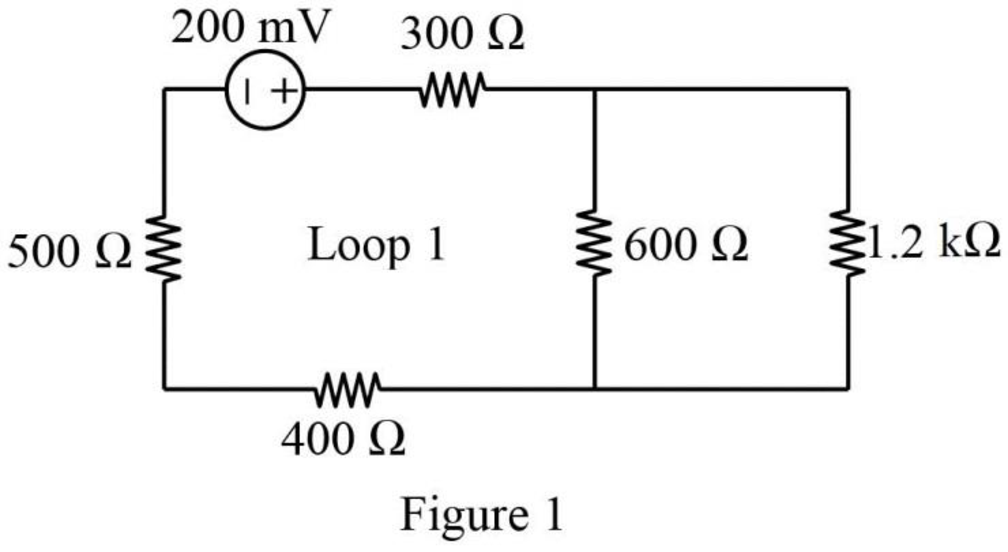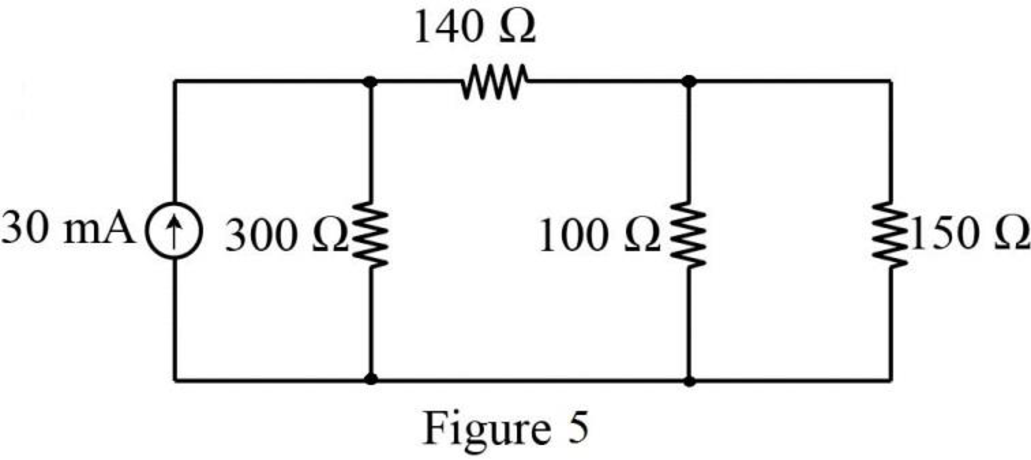
(a)
Mention the resistors connected in series for the given circuits in Figure P3.1.
(a)
Explanation of Solution
Given data:
Refer to the given circuit shown in Figure P3.1.
Calculation:
Figure P3.1(a):
Refer to Figure P3.1(a) in the textbook, the resistors connected in series are
Figure P3.1(b):
Refer to Figure P3.1(b) in the textbook, the resistors connected in series are
Figure P3.1(c):
The Figure P3.1(c) in the textbook is shown in Figure 1.

In Figure 1, the resistors connected in series (Loop 1) are the
Figure P3.1(d):
Refer to Figure P3.1(d) in the textbook, the resistors connected in series are
Conclusion:
Thus, the resistors connected in series for the given circuits are mentioned.
(b)
Find the equivalent resistors by simplifying the circuits of the series-connected resistors in Figure P3.1.
(b)
Explanation of Solution
Given data:
Refer to the given circuit shown in Figure P3.1.
Calculation:
Figure P3.1(a):
Refer to Figure P3.1(a) in the textbook,
Similarly,
The modified circuit is shown in Figure 2.

Figure P3.1(b):
Refer to Figure P3.1(b) in the textbook, the resistors
The modified circuit is shown in Figure 3.

Figure P3.1(c):
Refer to Figure P3.1(c) in the textbook, the resistors
The modified circuit is shown in Figure 4.

Figure P3.1(d):
Refer to Figure P3.1(d) in the textbook, the resistors
Similarly, the resistors
The modified circuit is shown in Figure 5.

Conclusion:
Thus, the simplified circuit is drawn for the series-connected resistors with equivalent resistors.
Want to see more full solutions like this?
Chapter 3 Solutions
ELECTRIC CIRCUITS& INTR. TO PSPIC W/MAS
Additional Engineering Textbook Solutions
Electric Circuits (10th Edition)
Introductory Circuit Analysis (13th Edition)
Electrical Engineering: Principles & Applications (7th Edition)
Fundamentals of Applied Electromagnetics (7th Edition)
Automotive Technology: Principles, Diagnosis, And Service (6th Edition) (halderman Automotive Series)
C How to Program (8th Edition)
 Introductory Circuit Analysis (13th Edition)Electrical EngineeringISBN:9780133923605Author:Robert L. BoylestadPublisher:PEARSON
Introductory Circuit Analysis (13th Edition)Electrical EngineeringISBN:9780133923605Author:Robert L. BoylestadPublisher:PEARSON Delmar's Standard Textbook Of ElectricityElectrical EngineeringISBN:9781337900348Author:Stephen L. HermanPublisher:Cengage Learning
Delmar's Standard Textbook Of ElectricityElectrical EngineeringISBN:9781337900348Author:Stephen L. HermanPublisher:Cengage Learning Programmable Logic ControllersElectrical EngineeringISBN:9780073373843Author:Frank D. PetruzellaPublisher:McGraw-Hill Education
Programmable Logic ControllersElectrical EngineeringISBN:9780073373843Author:Frank D. PetruzellaPublisher:McGraw-Hill Education Fundamentals of Electric CircuitsElectrical EngineeringISBN:9780078028229Author:Charles K Alexander, Matthew SadikuPublisher:McGraw-Hill Education
Fundamentals of Electric CircuitsElectrical EngineeringISBN:9780078028229Author:Charles K Alexander, Matthew SadikuPublisher:McGraw-Hill Education Electric Circuits. (11th Edition)Electrical EngineeringISBN:9780134746968Author:James W. Nilsson, Susan RiedelPublisher:PEARSON
Electric Circuits. (11th Edition)Electrical EngineeringISBN:9780134746968Author:James W. Nilsson, Susan RiedelPublisher:PEARSON Engineering ElectromagneticsElectrical EngineeringISBN:9780078028151Author:Hayt, William H. (william Hart), Jr, BUCK, John A.Publisher:Mcgraw-hill Education,
Engineering ElectromagneticsElectrical EngineeringISBN:9780078028151Author:Hayt, William H. (william Hart), Jr, BUCK, John A.Publisher:Mcgraw-hill Education,





